Welcome to the world of red birds in Massachusetts! This beautiful state is home to various red birds, including the Northern Cardinal, Scarlet Tanager, and Red-winged Blackbird.
Massachusetts is also home to several other colorful birds, including the Eastern Bluebird, Indigo Bunting, and Baltimore Oriole.
This guide will explore the fascinating and diverse world of red birds in Massachusetts, from their natural habitats to their behavior and conservation status. We hope you enjoy learning more about these beautiful creatures!
21 Red Birds in Massachusetts
In the heart of Massachusetts, amidst the tranquil beauty of its natural landscapes, an enigmatic phenomenon has captured the attention of birdwatchers, researchers, and curious locals alike.
Here are 21 Red Birds in Massachusetts.
1. House Finch
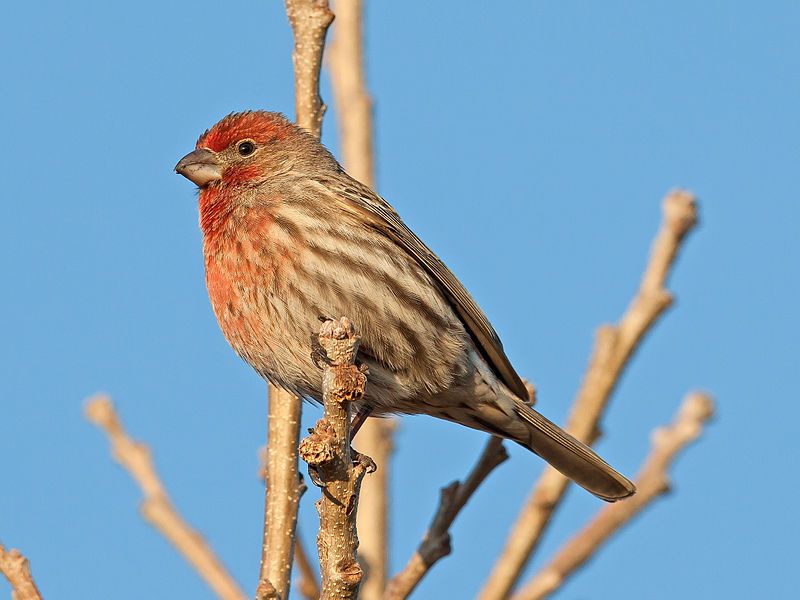
The house finch is a small bird belonging to the finch family Fringillidae. This species is native to western North America, including parts of Canada and Mexico, but it has been introduced to the eastern half of the continent and Hawaii.
The house finch is part of the genus Haemorhous, which includes two other species of American rosefinches. It has a short, conical bill and a reddish-brown head, back, and underparts, with a white underside.
The male is more brightly colored, with a bright red forehead and cheeks. House finches live in various habitats, including open woodlands, shrublands, and urban areas. They are omnivorous feeders and will eat both insects and seeds.
They are also popular as cage birds, with many being kept as pets.
| Kingdom | Animalia |
| Phylum | Chordata |
| Class | Aves |
| Order | Passeriformes |
| Family | Fringillidae |
| Genus | Haemorhous |
| Species | H. mexicanus |
2. Northern Cardinal
The northern cardinal is a species of bird found in North America. It is also known by several other common names, including “redbird”, “common cardinal”, “red cardinal”, and simply “cardinal”.
It is part of the genus Cardinalis, which includes other related species such as the Pyrrhuloxia, the Vermilion Cardinal, and the Black-headed Cardinal. The Northern Cardinal is notable for its bright red plumage, often called the “redbird.”
Males are brightly colored with a red crest, black face, and red body, while females are a dull, grayish-brown color. Cardinals are found in various habitats, from open woodlands and thick undergrowth to suburban gardens and city parks.
They feed on various foods, including seeds, fruits, insects, and even small vertebrates. Cardinals are known for their distinctive song, a loud, clear whistle. They are a famous bird among birdwatchers and are often seen in backyards across North America.
| Kingdom | Animalia |
| Phylum | Chordata |
| Class | Aves |
| Order | Passeriformes |
| Family | Cardinalidae |
| Genus | Cardinalis |
| Species | C. cardinalis |
3. Cardinalidae
Cardinalidae is a family of passerine birds native to the New World. This family includes cardinals, grosbeaks, and buntings, all songbirds.
It also includes other genera of birds, such as Piranga, like tanagers, and Granatellus, like warblers. These birds are found in various habitats, from woodlands and grasslands to deserts.
They have a variety of behaviors and diets, and many species are known to migrate. They have brightly colored plumage and are prevalent in aviculture.
| Kingdom | Animalia |
| Phylum | Chordata |
| Class | Aves |
| Order | Passeriformes |
| Family | Cardinalidae |
4. Scarlet Tanager
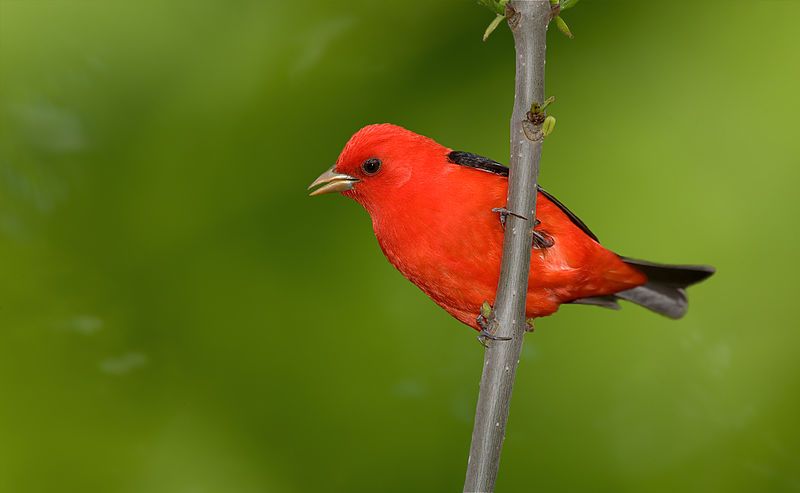
The scarlet tanager is a medium-sized American songbird that has recently been reclassified. Until recently, it was included in the tanager family, but it and other members of its genus are now classified as belonging to the cardinal family.
This reclassification was made based on the similarities between the scarlet tanager and the cardinal family regarding size, color, and behavior. The scarlet tanager is a striking bird with bright red feathers on its body, wings, and tail.
It is found throughout the eastern United States and parts of Canada and can often be heard singing its bright, melodic song. The scarlet tanager is a social species found in small flocks and frequently seen in mixed-species flocks with other songbirds.
Its diet consists mainly of insects and fruit, and it has a habit of gleaning prey from the underside of leaves. The scarlet tanager is an essential species for conservation, as it indicates the health of its habitat.
Its reclassification into the cardinal family reflects the close relationship between the two species and their similar characteristics.
| Kingdom | Animalia |
| Phylum | Chordata |
| Class | Aves |
| Order | Passeriformes |
| Family | Cardinalidae |
| Genus | Piranga |
| Species | P. olivacea |
5. Summer Tanager
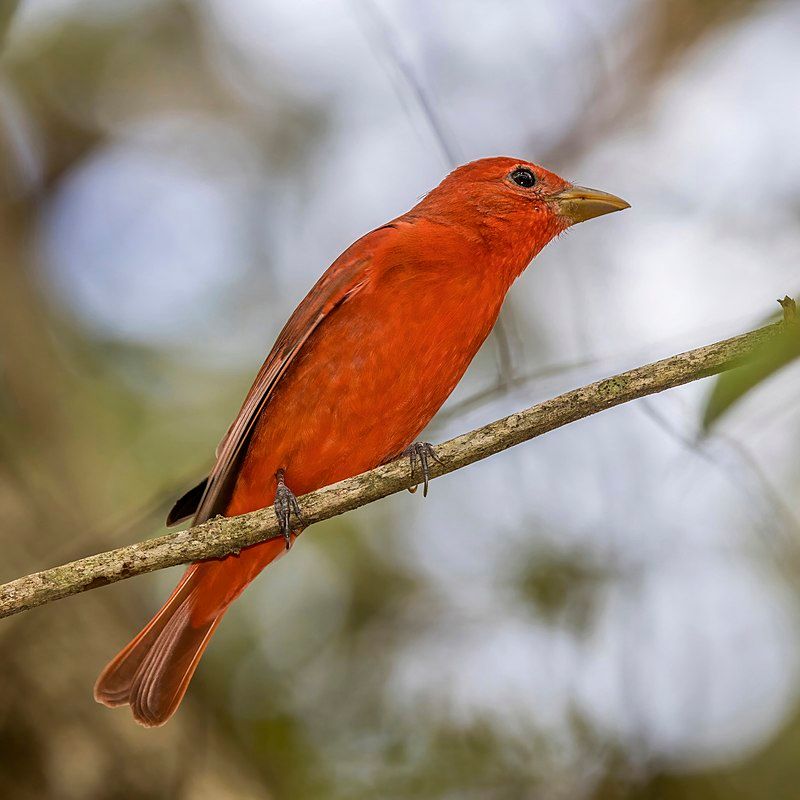
The summer tanager is a medium-sized songbird native to the Americas. It was previously categorized in the Tanager family but reclassified in the Cardinal family.
This is mainly due to the similarities in its plumage and vocalizations to other members of the cardinal family. The summer tanager has a bright red body with black wings and a yellowish-green head.
Its song is a musical warbling often compared to the song of the cardinal family. It feeds mainly on insects and fruits and is common in open woodlands and gardens. Its range extends from southeastern Canada down to Bolivia and Brazil.
The summer tanager is essential in its habitat, as its presence indicates a healthy and diverse ecosystem.
| Kingdom | Animalia |
| Phylum | Chordata |
| Class | Aves |
| Order | Passeriformes |
| Family | Cardinalidae |
| Genus | Piranga |
| Species | P. rubra |
6. Red Crossbill
The Red Crossbill, also known as the Common Crossbill, is a small songbird from the finch family Fringillidae. These birds are easily identifiable due to their unique beaks, crossed at the tips.
This physical adaptation has enabled them to extract seeds from conifer cones and other fruits. The Red Crossbill typically has a dark red-brown plumage and a broad tail. They measure around 14-17 cm in length and weigh around 20-36 grams.
These birds can be found in coniferous forests, woodlands, and mountain slopes. They feed mainly on conifers’ seeds and eat small insects and berries.
Red Crossbills often form flocks of up to several hundred birds and are known to migrate to warmer climates during the winter. They are also known to hybridize with other members of the finch family, such as the White-winged Crossbill and the Two-barred Crossbill.
Overall, the Red Crossbill is an exciting and unique bird from the finch family. With their crossed beaks, they can feed on the seeds of conifers and form flocks of hundreds of birds during migration.
| Kingdom | Animalia |
| Phylum | Chordata |
| Class | Aves |
| Order | Passeriformes |
| Family | Fringillidae |
| Genus | Loxia |
| Species | L. curvirostra |
7. Rose-Breasted Grosbeak
The rose-breasted grosbeak is a large, seed-eating bird from the cardinal family. It is commonly called the “cut-throat” due to its striking coloration.
The male bird has a black head, wings, back, and tail, with a bright rose-colored patch on its white breast. It is primarily a foliage gleaner, meaning it forages for food in the foliage of trees and shrubs.
This species is found across much of North America and some parts of South America. The rose-breasted grosbeak is an attractive and distinctive bird with a varied diet. It feeds on the seeds of various plants, small insects, and fruits.
The occasional egg or nestling of smaller birds supplements its diet. During the breeding season, it is commonly found in deciduous forests, where it can find plenty of food. In addition to being a seed-eater, the rose-breasted grosbeak is also an important pollinator.
It visits various flowers, including thistles and coneflowers, to collect nectar. This helps to spread the pollen of these flowers, aiding in their reproduction.
The rose-breasted grosbeak is an integral part of the North American ecosystem, and its presence indicates healthy, biodiverse habitats. Its striking coloration and varied diet make it a unique and fascinating species.
| Kingdom | Animalia |
| Phylum | Chordata |
| Class | Aves |
| Order | Passeriformes |
| Family | Cardinalidae |
| Genus | Pheucticus |
| Species | P. ludovicianus |
8. Common Redpoll
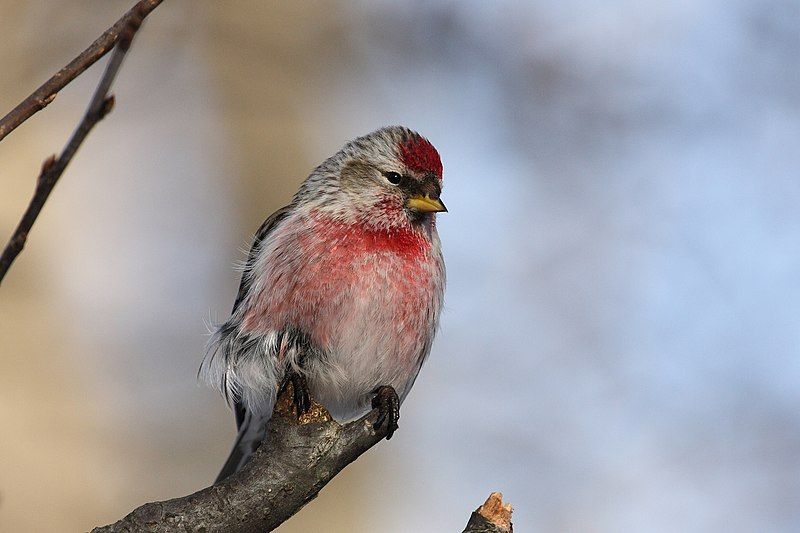
The common redpoll (also known as the mealy redpoll) is a species of finch that breeds in the more southern areas of the Arctic region. These birds inhabit areas filled with thickets and shrubs, allowing them to find food and protection from potential predators.
The common redpolls are often found in the same habitats as the Arctic redpolls, but they generally breed further south than the Arctic species. Common redpolls have a bright red cap, white-streaked wings, and a light brown body.
They have a short, forked tail and strong legs, allowing them to fly quickly and gracefully. They feed primarily on seeds but will also eat insects and berries. Common redpolls are typically found in flocks of several dozen birds, and they migrate south in the winter months.
They are a pretty social species and have a unique call similar to the sound of a squeaky wheel. The common redpoll is an essential species in the Arctic region, as it helps to disperse seeds and other vegetation.
This can help to ensure that the local ecosystem remains healthy and balanced.
| Kingdom | Animalia |
| Phylum | Chordata |
| Class | Aves |
| Order | Passeriformes |
| Family | Fringillidae |
| Genus | Acanthis |
| Species | A. flammea |
9. Two-Barred Crossbill
The two-barred crossbill, also known as the white-winged crossbill, is a small bird in the finch family Fringillidae. This passerine bird is found in North America and the Palearctic. The two-barred crossbill is known to inhabit coniferous forests, where it breeds.
It is a unique bird with a distinctive call and brightly-colored plumage. The two-barred crossbill has a colorful appearance, with its black, red, and yellow plumage. It has a thick, curved beak adapted for extracting seeds from conifer cones.
This bird also has a high-pitched, metallic call that is easily recognizable. The two-barred crossbill is an acrobatic bird that can hang upside down on pine cones to feed. It is also capable of hovering in mid-air while searching for food.
The bird’s diet consists mainly of conifer seeds but will also feed on small insects and berries. The two-barred crossbill is an integral part of the coniferous forest ecosystem.
Its presence helps to disperse the seeds of the coniferous trees, which in turn helps to ensure the health of the forest.
The two-barred crossbill is also an essential food source for other animals, such as hawks and owls. The two-barred crossbill is a unique and vital bird found in coniferous forests across North America and the Palearctic region.
Its distinctive call, colorful plumage, and acrobatic behavior are all factors that make it a fascinating bird to observe.
| Kingdom | Animalia |
| Phylum | Chordata |
| Class | Aves |
| Order | Passeriformes |
| Family | Fringillidae |
| Genus | Loxia |
| Species | L. leucoptera |
10. Painted Bunting
The painted bunting is a species of bird found in the cardinal family, Cardinalidae, and is native to North America. It is a unique species because it takes two years for a male to gain its bright plumage.
In its first year of life, the male and female are virtually indistinguishable from one another, other than upon close inspection. This bright plumage results from maturation and attracts a mate during the breeding season.
The female, however, does not go through this process and remains dull in color. Such differences in coloration make the painted bunting an exciting species to observe and study.
| Kingdom | Animalia |
| Phylum | Chordata |
| Class | Aves |
| Order | Passeriformes |
| Family | Cardinalidae |
| Genus | Passerina |
| Species | P. ciris |
11. Red-Headed Woodpecker
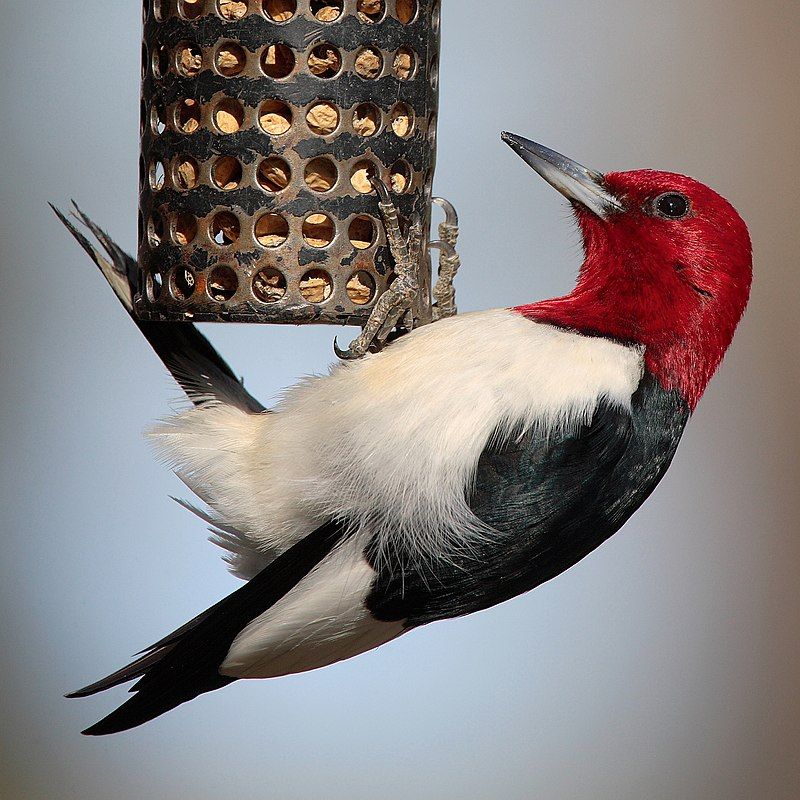
The red-headed woodpecker is a relatively small type of woodpecker that is found throughout temperate North America. This species is known to inhabit open country areas such as fields, forests, and pastures across southern Canada and the east-central United States.
The red-headed woodpecker is a colorful bird with a bright red head and neck, a black back, and white breast and abdomen. Additionally, this species has a white rump, black wings, and a white stripe on its wings. This woodpecker is also known for its loud, distinctive call.
During the breeding season, the red-headed woodpecker is often seen in pairs, drumming on trees or other objects to attract a mate. They also construct their nest in tree cavities or nest boxes.
The red-headed woodpecker is an omnivore, feeding on insects, nuts, fruits, small amphibians, and reptiles. This species is also known to visit bird feeders, making it a famous bird-watching species.
The red-headed woodpecker is a unique and easily recognizable species in temperate North America.
| Kingdom | Animalia |
| Phylum | Chordata |
| Class | Aves |
| Order | Piciformes |
| Family | Picidae |
| Genus | Melanerpes |
| Species | M. erythrocephalus |
12. Ruby-Throated Hummingbird
The ruby-throated hummingbird is a species found in many parts of North America. It is most commonly seen in the eastern parts of the continent and is known for its distinct ruby-red throat patch.
During winter, the ruby-throated hummingbird typically migrates to Central America, Mexico, and Florida. At this time, they spend their time enjoying the warmer temperatures.
As spring approaches, they migrate back to Canada and other parts of Eastern North America and settle in to breed. It is during this time that they are most visible and active.
They build their nests in trees and other areas of vegetation and spend their days feeding on insects and nectar. The ruby-throated hummingbird is an integral part of the North American ecosystem and plays a vital role in pollination.
| Kingdom | Animalia |
| Phylum | Chordata |
| Class | Aves |
| Clade | Strisores |
| Order | Apodiformes |
| Family | Trochilidae |
| Genus | Archilochus |
| Species | A. colubris |
13. Northern Flicker
The northern flicker is a type of woodpecker native to most of North America, Central America, Cuba, and the Cayman Islands. It is a medium-sized bird with an overall length of about 11-14 inches.
Its body is mainly covered with a mottled brown and white coloration. Its wings and tail are tipped with black and white barring. It has a black line on its neck and a red crescent on its chest. It has a yellow underside, which it uses to attract mates.
The northern flicker is an omnivorous species, normally eating insects, fruits, and nuts. It is an active forager, often seen on the ground. It has a loud, distinctive call frequently heard echoing through woodlands.
It is one of the few woodpecker species that migrate, usually traveling south during winter. Its migratory habits make it more widespread than other woodpecker species. The northern flicker is a common bird in many parts of North America.
It is a favorite of birdwatchers due to its unique markings and vocalizations. It is also a beneficial species, helping to control insect populations and dispersing the seeds of various plants.
With its colorful plumage and unique behaviors, the northern flicker is an iconic bird of North America.
| Kingdom | Animalia |
| Phylum | Chordata |
| Class | Aves |
| Order | Piciformes |
| Family | Picidae |
| Genus | Colaptes |
| Species | C. auratus |
14. Red-Breasted Nuthatch
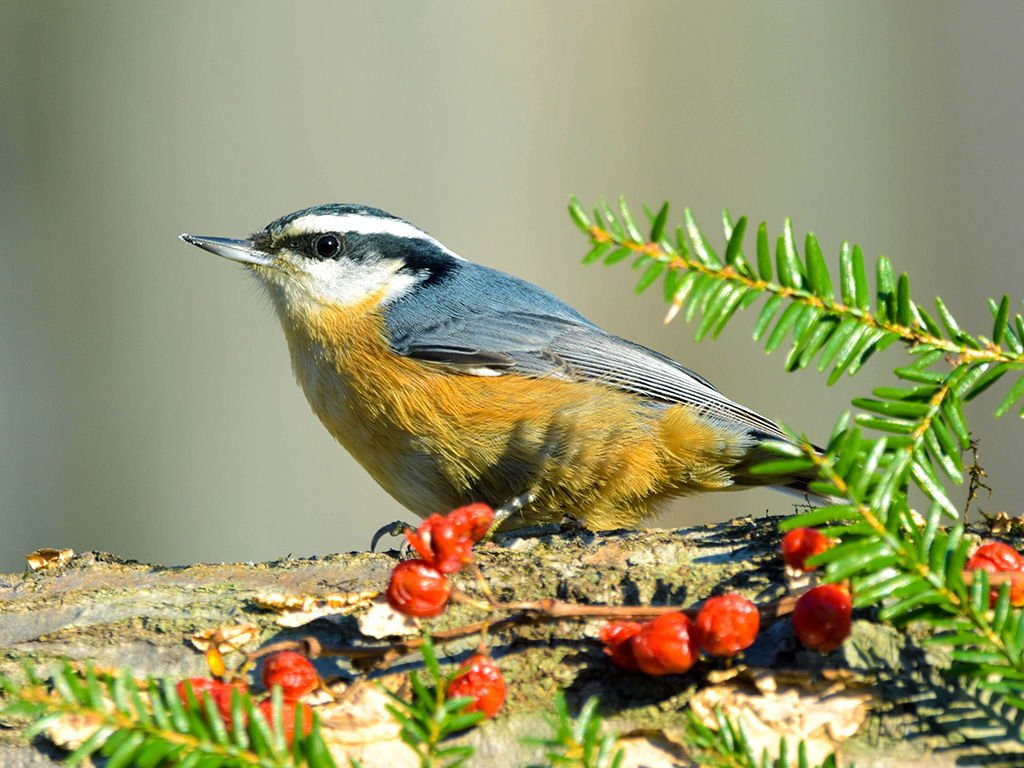
The red-breasted nuthatch is a small songbird with distinct physical features. Its upper parts are a striking blue-grey, contrasting with its cinnamon-colored underparts. It has a white throat and face, marked with a black stripe that runs from the bill through the eyes.
Its bill is straight and grey, and its head is crowned with black feathers. This bird is easily identified by its distinctive call, likened to a tin trumpet.
Its voice is high-pitched and nasal, distinct from other birds. The red-breasted nuthatch is a truly remarkable creature. Its colorful plumage and unique call make it a delight to spot in the wild.
| Kingdom | Animalia |
| Phylum | Chordata |
| Class | Aves |
| Order | Passeriformes |
| Family | Sittidae |
| Genus | Sitta |
| Species | S. canadensis |
15. Palm Warbler
The palm warbler is a type of bird that belongs to the New World warbler family. This bird species is relatively small, measuring 5-6 inches long, with a wingspan of up to 8 inches. It is recognizable by its yellowish-olive upperparts and white underparts.
Its face has a distinct yellowish-orange coloration, and it also has a yellowish-brown throat and breast.
The chunky, short-tailed bird is also known to have a thin stripe of black that runs along its crown. The palm warbler is native to North America and can be found in the United States, Canada, and Mexico.
It is typically found in open grasslands, deciduous woodlands, and coniferous forests.
They like to stick to areas with thick shrubbery and vegetation, as they use it to hide from predators. The diet of the palm warbler consists mainly of insects and spiders, as well as some fruits and seeds. They also enjoy snacking on small berries and other vegetation.
This migratory bird species will travel south when the weather gets cooler. The palm warbler is an important species to the environment, as it helps to keep insect populations in check.
They are also common and can be seen everywhere across North America.
| Kingdom | Animalia |
| Phylum | Chordata |
| Class | Aves |
| Order | Passeriformes |
| Family | Parulidae |
| Genus | Setophaga |
| Species | S. palmarum |
16. Red-Winged Blackbird
The red-winged blackbird is a type of bird known as a passerine, meaning it belongs to the order Passeriformes, which includes more than half of all bird species.
It is found in the family Icteridae, which includes several species of blackbirds, orioles, meadowlarks, cowbirds, and grackles. These birds are found in most North America, from Alaska to Central America, and even as far south as Panama.
They prefer open habitats such as meadows, marshes, and the edges of forests and are often seen perched on fence posts or wires. Red-winged blackbirds are easily recognizable with their bright red and yellow shoulder patches and black feathers.
They are medium-sized, measuring about 7-9 inches long, and have a wingspan of around 13 inches. They are omnivorous, eating various insects, grains, berries, and other small animals.
They are also known to be very vocal, with various chirps and whistles. Red-winged blackbirds are an essential species in many North American ecosystems, playing a role in controlling insect populations and helping to disperse seeds and fruits.
They are also famous in many areas and can often be seen in large flocks.
| Kingdom | Animalia |
| Phylum | Chordata |
| Class | Aves |
| Order | Passeriformes |
| Family | Icteridae |
| Genus | Agelaius |
| Species | A. phoeniceus |
17. Red-bellied woodpecker
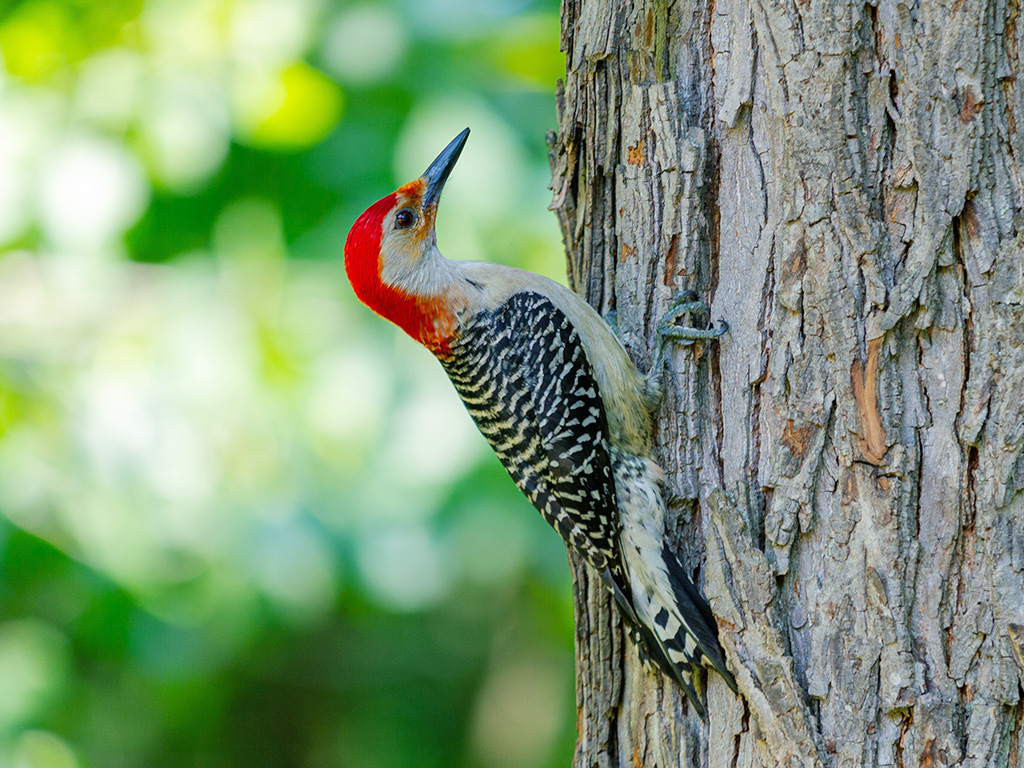
The red-bellied woodpecker is a common bird that belongs to the family of Picidae, a group of birds that includes woodpeckers and their allies. It is a medium-sized woodpecker with a length of about 8-10 inches and a wingspan of 13-15 inches.
These birds have distinctive red heads and bellies, with black and white stripes running down their backs. Their bills are long and pointed, and they have long, stiff tail feathers.
The red-bellied woodpecker is mainly found in the eastern United States, from Florida in the south to Canada in the north. They are also occasionally found in the Midwest and some parts of Mexico.
They commonly inhabit deciduous and mixed forests, woodlands, edges, and parks. The breeding season for the red-bellied woodpecker typically occurs between April and June.
During this time, the male woodpecker will use its bill to drill a hole in the side of a tree to create a nest cavity. The male and female woodpeckers will then line the cavity with wood chips and moss.
The female will lay a clutch of 4-6 white eggs, which will be incubated for approximately two weeks. Once the eggs have hatched, both the male and female will be responsible for feeding the young.
The red-bellied woodpecker is an integral part of the eastern US avian community, providing food sources for other birds and animals. They are also popular with bird watchers due to their attractive appearance and interesting behavior.
| Kingdom | Animalia |
| Phylum | Chordata |
| Class | Aves |
| Order | Piciformes |
| Family | Picidae |
| Genus | Melanerpes |
| Species | M. carolinus |
18. Woodpeckers
The bird family Picidae is a large family of birds, which includes the woodpeckers, piculets, wrynecks, and sapsuckers.
These birds can be found in various habitats, from forests to deserts. They are on every continent except Australia, New Guinea, New Zealand, Madagascar, and the extreme polar regions.
Woodpeckers can be identified by their long, pointed beaks and strong, chisel-like toes, which they hammer and peck into tree bark to find insects to eat. They also have stiff tail feathers, which help them brace themselves against tree trunks while they feed.
Piculets are smaller than woodpeckers but have similar beaks and feet. Wrynecks and sapsuckers both have short beaks and feed on sap from trees. All these birds are essential to their local ecosystems and are crucial in controlling insect populations.
| Kingdom | Animalia |
| Phylum | Chordata |
| Class | Aves |
| Order | Piciformes |
| Family | Picidae |
19. Downy Woodpecker
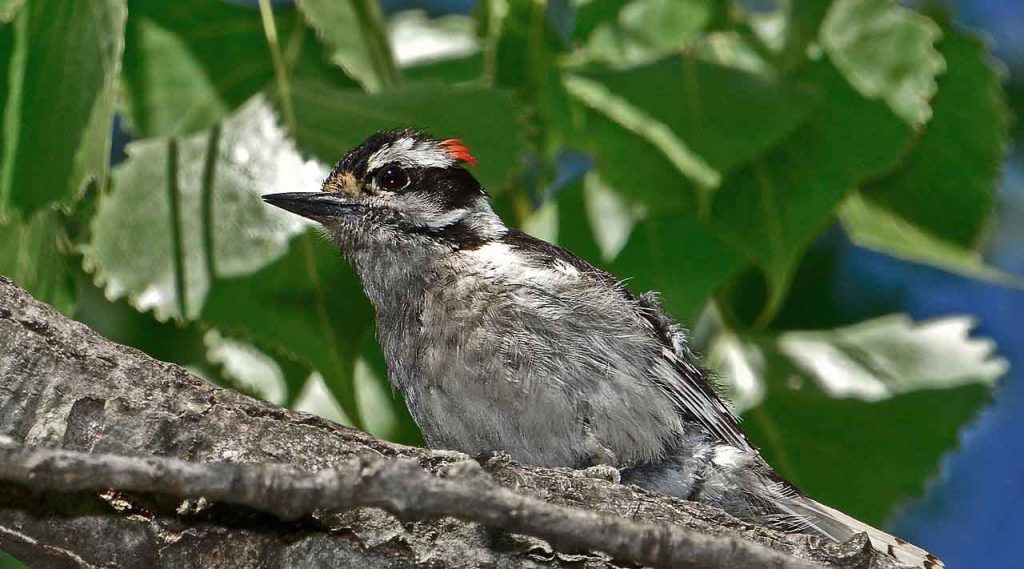
The Downy Woodpecker is a species of woodpecker found in North America and is the smallest of all the woodpeckers in this region. Its length varies from 14 to 18 cm, making it relatively small.
This species of woodpecker mainly lives in the forests of the United States and Canada, except in the deserts in the southwest of the United States and the northern tundra.
They are known to feed on insects, such as beetles, and can also occasionally be seen eating fruits and nuts. The Downy Woodpecker is a keystone species, meaning it helps maintain its environment’s balance.
For example, feeding on insects that may destroy trees helps keep the balance of the forest. It is also an essential part of the food chain in many ecosystems. The Downy Woodpecker is a very vocal bird.
It has a distinctive call that is often heard in the forests. It is also known to drum on trees with its bill to attract mates or announce its presence. This woodpecker species also uses tools, such as thin sticks, to probe into trees for food.
The Downy Woodpecker is a beautiful bird with a black and white speckled body and a red patch on its head. They are also known to be very social birds and are often found in groups of two or three.
They can be essential to any backyard bird-watching experience and are a great addition to any home.
| Kingdom | Animalia |
| Phylum | Chordata |
| Class | Aves |
| Order | Piciformes |
| Family | Picidae |
| Genus | Dryobates |
| Species | D. pubescens |
20. Ruby-Crowned Kinglet
The ruby-crowned kinglet is a tin but lively passerine bird throughout North America. It belongs to the kinglet family, a small family of birds known for their active behavior.
The bird has an olive-green plumage, with two white wing bars and a white eye-ring, which gives it a distinctive look. Males of this species have a unique feature: a red crown patch usually hidden in its feathers.
This patch is used for courtship displays and is usually hidden when not in use. The ruby-crowned kinglet is a famous bird for birdwatchers, as its size and beautiful plumage make it an easy target for observation.
| Kingdom | Animalia |
| Phylum | Chordata |
| Class | Aves |
| Order | Passeriformes |
| Family | Regulidae |
| Genus | Corthylio |
| Species | C. calendula |
21. Arctic Redpoll
The Arctic redpoll, also known as the hoary redpoll, is a bird species in the finch family Fringillidae. It is native to the tundra birch forests of Greenland and certain parts of Canada, as well as the northern regions of North America and the Palearctic.
Two recognized subspecies of the Arctic redpoll are A. h. horseman and A. h. exiles.
The former is found in Greenland and the surrounding Canadian areas, while the latter breeds in the tundra of both North America and the Palearctic. The Arctic redpoll is a small bird with a bright red forehead, a white throat, and a grayish-brown body.
It has a short, conical bill and a forked tail. Its wingspan is around 19 cm and weighs an average of 16–19 g.
The Arctic redpoll is a migratory species whose diet consists mainly of seeds, buds, and insects. The Arctic redpoll typically builds its nests in trees or shrubs, using grass and feathers mixed with mud to make the nest cup.
The female lays a clutch of 2-7 eggs, incubated for 11-14 days. The chicks usually fledge after around 12-13 days. The Arctic redpoll is listed as least concern by the IUCN Red List and is currently in no immediate danger of extinction.
However, its population has decreased due to losing its natural habitat, and it is now considered a conservation concern. As a result, the species is protected under various international agreements.
| Kingdom | Animalia |
| Phylum | Chordata |
| Class | Aves |
| Order | Passeriformes |
| Family | Fringillidae |
| Genus | Acanthis |
| Species | A. hornemanni |
Conclusion
Redbirds are a common sight in Massachusetts. They are found in many habitats, from forests and fields to backyards and city parks. Redbirds are a beautiful and unique species, bringing joy to many people in the state.
We can ensure that red birds will continue to thrive in Massachusetts for many years with careful conservation efforts.